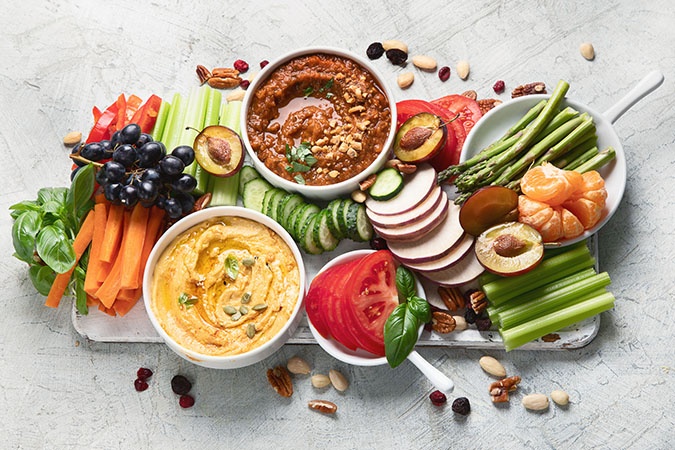How to Use Food for Long Term Muscle and Bone Health

The following article was written by Heinen’s Chief Medical Officer, Dr. Todd Pesek, MD.
Your musculoskeletal (muscle and bone) health is, in essence, your longevity currency. In other words, the degree to which you maintain muscle and bone mass can directly correlate to the quality and even quantity of one’s life.
Keep in mind, one of two woman and one of four men, over fifty, suffer a fracture due to osteoporosis, or “porous (and therefore weak) bones,” and half of those who suffer a hip fracture, specifically over fifty, succumb to the injury within a year. While these statistics may seem jarring, they are important to understand, as there are workarounds available. You might be asking, well, what are they? How does one avoid such an unfortunate occurrence?
It’s not as hard as you may think.
The Connection Between Muscle and Bone Health and Nutrition and Exercise
A healthy diet and lifestyle affect both your muscles and bones similarly. We know that with nutrient dense, healthful foods and regular exercise your muscles get bigger and stronger. Conversely, if you are sitting around all day, the opposite holds true. The same thing occurs with your bones, but the change is much slower and therefore less noticeable from day-to-day.
The positive response of muscle and bone to nutrition and exercise happens concurrently, as their health is intertwined. There is a delicate balance at play here. Think of what would occur if you had a strong muscle and a weak bone; the muscle could snap the bone. Similarly, puny muscles moving around dense and heavy bone isn’t going to get you very far.
Our bodies maintain the correct balance and are challenged to rise to the occasion through physical activity fueled by proper nutrition. As our muscles grow stronger, they pull harder on our bones and therefore make them bear load. As this occurs, our physiology strengthens our bones with available nutrients. The opposite holds true as well: if your muscles aren’t working your bones or there is a scarcity of nutritious building blocks, then they can grow weaker as well.
The building blocks of your muscle and bone is principally protein. In bone, about ninety percent of that protein is collagen, which then gets mineralized by calcium phosphate, making them hard. This process is ongoing with the turnover of bone, and eventually begins to slow down as one ages. It is important to stimulate the production of new bone to maintain the density.
Consume the Right Nutrients
With physical activity, your body has a relative increased need for nutrients, including balanced proteins. Let strategic snacking and perhaps a protein-rich smoothie or two help you with those needs. Most Americans derive almost half of their caloric intake daily from snacking, so choose wisely. Perhaps throw some of your favorite soaked or sprouted nuts and seeds on your salads, or just munch them throughout the day. Snacks throughout the day will nourish your active body and keep unhealthy cravings in check.
I know you’ve heard this before, and it remains true: prepare in advance. So do just that and keep any of these items with you throughout the day for balanced snacking.
- Trail mix, pumpkin seeds, almonds or other seeds and nuts
- Veggies and nutritious dips, like hummus or your favorite homemade accoutrements
- Fruit like blueberries or raspberries

Expert Tip: Good snacking containers are worth the investment, as they’re easy to transport and keep your snacks fresh.
Focus on solutions that are rich in nutrients and balanced proteins, but low in sugar. I am giving you the Doc’s orders to snack your way to health. Be sure to focus on greens, veggies and balanced proteins, as our Seven Fx™ Pillars of Optimal Health suggest, to support your increased activity!
Since your muscle and bones are largely fueled by proteins and essential nutrients like vitamins C, K and D along with calcium, phosphorous, magnesium, manganese, silica and sulfur, you should prioritize eating foods that are rich in proteins and these essential nutrients. This is quite easy to accomplish by shifting your snacking focus to nuts, seeds, legumes and greens.
Importantly, a dietary focus such as this also supports healthful inflammatory balance in the body. Inflammation is what causes pain and tenderness in joints and tissues, but also drives the gamut of chronic health conditions. Working at a reduction is a bonus for sure!
Hang out in Nature and Use Your Body Everyday
Go walking or hiking daily.
In addition to a daily walk or hike, you need both resistance exercise (a minimum of thirty minutes weekly, but ideally daily), and aerobic exercise for twenty minutes at a minimum of three times a week, but again ideally daily (at roughly 80% max heart rate). Also, remember to stretch daily (just like your cat or dog first thing in the morning!).
Activity is essential to good health, and you literally need exercise. I will say it again: you must use your body every day. It is how we are designed, and the only way to achieve true health. Many communities have free or inexpensive exercise programs to get you started, and many studios and fitness facilities have complementary classes for new students. Grab a friend if you’d like, be creative and have fun. You can combine daily movement and stretching, resistance and aerobic training into single activities, too— such as Yoga or Tai Chi (bonus with these: you get the added benefit of daily meditation). Mix it up and surprise yourself with just how much fun you’ll have.

In short, eat those nutrient dense foods, and get up and moving—everyday!
If you’d like to learn more, join Dr. Todd Pesek, M.D., Heinen’s Chief Medical Officer at select free Club Fx events.


